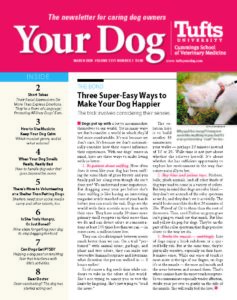Taking Your Dog’s Meds to Save Money on Prescriptions
The price of prescription drugs for people in the U.S. can be two to four times higher than in other industrialized countries, while the same drugs prescribed for dogs by veterinarians can sometimes be considerably less expensive. So should you take medicines meant for your pet to treat your own illness? Definitely not.
Subscribe to Tufts Your Dog
Already Subscribed?
Click Here to Sign In | Forgot your password? | Activate Web AccessFDA Issues Warning on Canine Arthritis Drug
Two years ago, the Food and Drug Administration approved a new drug for arthritis in dogs called Librela (bedinvetmab). Given by injection, the medicine reduces arthritis pain by binding to a protein called canine nerve growth factor (NGF). That prevents pain signals from reaching the brain.
Subscribe to Tufts Your Dog
Already Subscribed?
Click Here to Sign In | Forgot your password? | Activate Web AccessWhen the Pupils Become Two Different Sizes
You notice that the pupils—the black circles in the center of your dog’s eyes—are no longer the same size. One has become significantly larger than the other, blocking out much of the iris (the colored part). Or one has become significantly smaller. Either way, it’s not normal. Both pupils are supposed to enlarge to the same degree to allow more light in when the ambient light has dimmed, and they’re supposed to shrink to the same degree to let in less light when the surrounding light has brightened. The condition of one pupil remaining a different size from the other no matter what is called anisocoria, from the Greek aniso, meaning “unequal,” kore, meaning “pupil,” and the Latin suffix ia, signifying “abnormal.”
Subscribe to Tufts Your Dog
Already Subscribed?
Click Here to Sign In | Forgot your password? | Activate Web AccessViolent skin eruption
Q: I am fostering a dog from the local shelter with a skin infection. Her name is Dakota Johnson, and she looks like an American hairless terrier crossed with fossilized stone. Circular, crusty, sometimes oozing spots are all over her body. And some areas have what look like little pimples. The first two weeks of oral antibiotics, topical antibacterials, and anti-fungal treatment didn’t help. The next two weeks of allergy meds and steroids seemed to be be clearing up the situation. She was scratching less and became interested in eating, and her skin was seeming to heal. But on the third week of giving the steroids every other day things went downhill. New spots have formed, some of them sticky, and a weird smell she had is back. The shelter had a biopsy done and said she had allergies but gave no indication of what she is allergic to. Is there a blood or skin test to find out?
Subscribe to Tufts Your Dog
Already Subscribed?
Click Here to Sign In | Forgot your password? | Activate Web AccessWhat’s a Clinical Exam?
Readers have asked us the difference between an exam and a clinical exam. A clinical exam is simply the doctor’s examination of a patient’s body (dog or human) in person, rather than, say, by phone or by looking over medical records. It’s the “show” part of a medical show-and-tell, and it’s a critical screening tool.
Subscribe to Tufts Your Dog
Already Subscribed?
Click Here to Sign In | Forgot your password? | Activate Web AccessDog Dandruff: It’s Not Normal
Very mild dandruff on a black dog is probably nothing to be concerned about. Even a few white flecks against a black backdrop are going to stick out. But generally speaking, you’re not supposed to be able to see dandruff scales on your pet. Normally, as millions of cells in the top layer of skin—the epidermis—are renewed every three to four weeks (just as in people), the old ones slough off upon dying. It takes place microscopically and shouldn’t be viewable.
Subscribe to Tufts Your Dog
Already Subscribed?
Click Here to Sign In | Forgot your password? | Activate Web AccessBetween Dying and Death, There’s Hospice
What people tend to think of when their dog has an illness with a grim prognosis is “a kind of binary option, either full-court treatment or euthanasia,” says Eric Richman, MSW, LICSW, a veterinary social worker who tends to clients at Tufts. But there’s “potential for middle ground,” he says, in the form of hospice and palliative care—“palliative” meaning pain-relieving as opposed to disease-treating.
Subscribe to Tufts Your Dog
Already Subscribed?
Click Here to Sign In | Forgot your password? | Activate Web AccessWhich Dogs Should Have Regular Breast Exams?
If your dog was spayed before she had even a single heat, she has virtually no chance of ending up with mammary (breast) cancer. But her risk for that disease rises substantially if her spaying occurred after the first heat. And if she wasn’t spayed till after her third or fourth heat, any potential cancer-sparing benefit may have been lost completely.
Subscribe to Tufts Your Dog
Already Subscribed?
Click Here to Sign In | Forgot your password? | Activate Web AccessBringing in the Expertise of a Veterinary Cardiologist Without Actually Having to Bring in...
AI—Artificial Intelligence—is often thought of as a kind of creepy, subversive use of information that does everything from allow students to cheat on their term papers to inadvertently promulgate falsehoods. But while it certainly can be misused, it also has amazing potential to do good, including in the care of dogs. It may even be able to help veterinarians pinpoint with better accuracy whether a dog has a heart murmur that would benefit from medication, an echocardiogram that would allow for further evaluation, or a referral to a board-certified veterinary cardiologist. In that way, it can both save people with dogs from spending money unnecessarily if the murmur is in fact not a significant health issue as well as better insure that a dog will receive prompt treatment if he does have a murmur that calls for further testing and/or a consult with a specialist.
Subscribe to Tufts Your Dog
Already Subscribed?
Click Here to Sign In | Forgot your password? | Activate Web AccessAvoid Canine Frost-bite and Other Cold Weather Hazards
It’s a common belief that dogs are more resistant to cold weather than people because of their fur, but that’s not true. Granted, longer-haired and thick-coated dog breeds like huskies and other dogs bred for colder climates are more tolerant of cold weather than dogs in general. But even dogs that don’t complain or don’t seem to mind are susceptible to frostbite and hypothermia. When the weather is extremely cold, shorten your outdoor time with your pet.
Subscribe to Tufts Your Dog
Already Subscribed?
Click Here to Sign In | Forgot your password? | Activate Web AccessIf Only My Dog Would Die in His Sleep
For our dogs as well as our human loved ones, we wish for health right up until the moment of death. Part of the reason, says Tufts Cummings School veterinary social worker Eric Richman, MSW, is that “some people tend to be uncomfortable with conversations about death and dying. If a dog dies peacefully in his sleep, they may see it as a way to avoid those difficult discussions.”
Subscribe to Tufts Your Dog
Already Subscribed?
Click Here to Sign In | Forgot your password? | Activate Web AccessYour Dog Doesn’t Have to Be White to Have Little White Shaker Syndrome
Your dog has always been perfectly fine but now has begun experiencing full-body tremors, or maybe tremors localized to one region, such as the head. Depending on the dog, the tremors range from mild to so severe that they are debilitating and perhaps include loss of balance. In some cases, they are accompanied by nystagmus—back-and-forth or circular eyeball movement that is clearly not in the dog’s control. The tremors tend to increase with exercise, stress, or excitement. What’s going on?

















